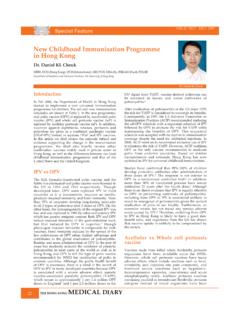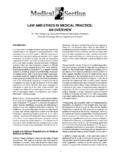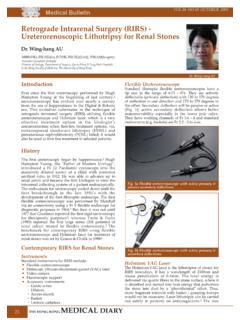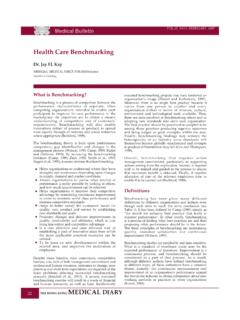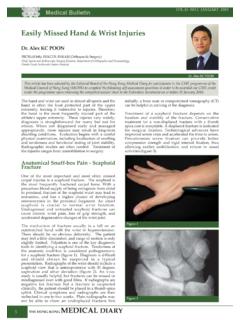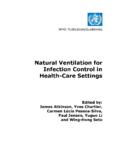Transcription of Ocular Toxicity of Ethambutol - fmshk.org
1 Ocular Toxicity of EthambutolIntroductionEthambutol hydrochloride is one of the first line agents employed in the treatment of tuberculosis , which remains an important infectious disease in Hong Kong, classified by the World Health Organization as "place with intermediate burden and a good health infrastructure". Being a commonly used drug, Ocular Toxicity of Ethambutol has been described since its first use in treatment of tuberculosis in 1960s1,2, manifesting as optic neuritis in affected individuals. Data regarding this potential side effect have been published, yet much controversy remains, especially on the issue of prevention of Ocular Toxicity of Ethambutol .
2 The article aims to give a summary of literature published on Ethambutol Ocular Toxicity - background, clinical presentation, Toxicity characteristics, management, monitoring and preventive have performed a search in MEDLINE from 1962 through 2005, using the search formula: ( Ethambutol OR myambutol) AND ( eye* OR ophthal* OR Ocular ) AND ( adverse OR toxic ). All relevant publications in English were uncommonly seen in patients on standard dosage, optic neuritis is the most important potential side effect of Ethambutol hydrochloride. Retrobulbar neuritis is most common, with involvement of either axial fibres or less commonly, periaxial fibres. Mixed pattern is possible. 3,4 Other rarer side effects of Ethambutol include peripheral neuropathy, cutaneous reactions (rash, pruritis, urticaria etc.)
3 , thrombocytopenia and hepatitis. 5, 6 Exact mechanism of Ocular neurotoxic effect of Ethambutol is yet to be identified. Animal studies have demonstrated Ethambutol Toxicity on retinal ganglion neurons in rodents. Hypotheses for its Toxicity have been made, including zinc-chelating effect of Ethambutol and its metabolite 7, 8, 9, and excitotoxic pathway PresentationThe onset of Ocular symptoms is usually delayed, occurring months after therapy initiation, though rare cases of Toxicity occurring few days after initiation have been reported, one on standard dosage of 15mg/kg/day, another on 25mg/ ,12 No study has reported onset after stopping Ethambutol . Clinical course can be acute or chronic and typically, progressive.
4 A f f e c t e d i n d i v i d u a l s m a y c o m p l a i n o f b i l a t e r a l progressive painless visual blurring. Decreased colour perception may also be experienced. Central vision is most commonly affected, though other visual field loss has also been described. Some individuals may be asymptomatic with abnormalities detected only by vision physical examination, both eyes are usually affected symmetrically. Physical findings can be very variable. Pupils may be bilaterally sluggish to light with no relative afferent pupillary defect. Visual acuity drop varies greatly from nil or minimal reduction to no light perception. Central scotoma is the most common visual field defect, but bitemporal defects13 or peripheral field constriction have been reported.
5 Dyschromatopsia (abnormal colour perception) may be the earliest sign of toxicity14, classically documented to be red-green colour changes. In contrary, the report by Polak et al stated that blue-yellow defects were the most common and early defect in patients without any visual symptoms15. However, the subtle blue-yellow defects could only be detected using the generally unavailable desaturated p a n e l o f L a n t h o n y a n d n o t I s h i h a r a c h a r t s n o r Farnsworth-Munsell D-15 test. Fundoscopic examination is usually normal. Characteristics of Ocular Toxicity of ethambutolClassically, the Ocular Toxicity is described as dose and duration related, and is largely reversible on drug discontinuation.
6 However, the issue of reversibility is challenged by many recent relatedStudies gave a reported incidence of Ethambutol related retrobulbar neuritis of 18% in patients receiving >35mg/kg/day, 5-6% with 25mg/kg/day and <1% with 15mg/kg/day of Ethambutol HCL for more than two ,16No "safe dosage" for Ethambutol was reported17, with Toxicity observed at a dose as low as mg/kg18. In Hong Kong, the usual daily dosage is 15mg/kg for adults and children, therefore, Ethambutol Ocular Toxicity is not commonly seen in Hong Kong. As the major excretion pathway of Ethambutol is by the kidneys, patients with poor renal function are at higher risk of Ocular toxicities.
7 Other factors predisposing subjects to Ethambutol Toxicity include diabetes and optic neuritis related to tobacco and alcohol. 19, 20 Duration relatedManifestation of Ocular Toxicity is usually delayed, which Dr. Alvin Kwok MD(HKU), MD(CUHK), FRCS(Edin), FCSHK, FCOphthHK, FHKAM(Ophthalmology), PDip Biostat & Epidem(CUHK), MBBS(HKU)Dr. Alvin KwokPresident, Hong Kong Ophthalmological Society 27 EditorialDrug FEBRUARY 2006generally does not develop until after treatment for at least Variable mean interval between onset of therapy and toxic effects were reported, from three to five , 17, 21 Manifestations of Toxicity as late as 12 months after therapy initiation were ,23 However, these report series were of small scales with unknown generalisability.
8 ReversibilityViews on the issue of reversibility of Ethambutol Toxicity are divided. Although classically described as reversible on discontinuation of Ethambutol (with visual acuity recovery over period of weeks to months), studies have reported permanent visual impairment without recovery i n s o m e p a t i e n t s w i t h p r o m p t e t h a m b u t o l discontinuation, within a follow up period ranging from six months to three years. 13, 17, 20, 21, 23 No risk factor was identified for the poor visual recovery, although a study showed statistically significant difference in visual recovery between groups of over 60 years old and below 60 years Even in patients with visual improvement after therapy discontinuation, complete recovery was not always ,23 Progressive worsening of vision after Ethambutol discontinuation was also However, these report series are again of small scale with unknown generalisability, and only patients with severe visual deficits were recruited.
9 Furthermore, queries were made on the possible contribution of isoniazid induced Ocular Toxicity to the observed irreversibility, as isoniazid is not withdrawn together with Ethambutol in the affected individuals. 23 ManagementUpon recognition of Ethambutol induced Ocular Toxicity , the drug must be immediately discontinued and patient referred to ophthalmologists for further evaluation. T h e r a p y d i s c o n t i n u a t i o n i s t h e o n l y e f f e c t i v e management currently, which can stop the progression of vision loss and allow recovery of vision. Some authors recommend that when severe Ocular Toxicity occurs, both isoniazid and Ethambutol are to be stopped immediately and consider adding other anti-tuberculous agents to control tuberculosis .
10 Isoniazid should also be stopped 6 weeks after stopping Ethambutol if Ocular Toxicity is not severe but with no vision improvement. 23 Recommendations on monitoring and preventive measuresSeveral international guidelines have been published to suggest measures for prevention and early detection of Ethambutol induced Ocular Toxicity . In August 2002, a g u i d e l i n e 2 4 o n t h i s i s s u e w a s p u b l i s h e d b y t h e tuberculosis and Chest Service of the Department of Health of Hong Kong Special Administrative Region (Table 1), based upon available clinical information, international guidelines and local experts' experiences25, 26, 27.
